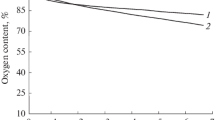Summary
(1) The effects of glycerol-treatment on the ultrastructure, tension, and electrical properties of rat sternomastoid muscle fibers are described. (2) The effect upon the ultrastructure of fibers differed from that previously reported for amphibian fibers, in that the sarcoplasmic reticulum, as well as the T-system, was disrupted. (3) Tension (tetanus and K-contracture) was abolished when preparations were returned to normal Krebs after exposure to a glycerol-Krebs solution (exposure periods were 1 hr in 200–350mm-glycerol or 10–60 min in 350mm-glycerol), although fibers had normal resting membrane potentials and action potentials. (4) Fibers treated for 1 hr with 350mm-glycerol were detubulated when returned to normal Krebs. Specific membrane capacity was reduced and exogenous horseradish peroxidase (HRP) did not penetrate the T-system. (5) Fibers were not detubulated after treatment for 1 hr with 200 to 300mm-glycerol or after treatment for 10 to 30 min with 350mm glycerol. Specific membrane capacity and resistance were normal and HRP entered the T-system. (6) Ultrastructural disruption of the triad junction became progressively more extensive with increasing glycerol concentration used and may be responsible for uncoupling.
Similar content being viewed by others
References
Adrian, R.H., Almers, W. 1973. Measurement of membrane capacity in skeletal muscle fibres.Nature New Biol. 242:62
Chandler, W.K., Rakowski, R.F., Schneider, M.F. 1976. Effects of glycerol treatment and maintained depolarization on charge movement in skeletal muscle.J. Physiol. (London) 254:285
Costantin, L., Franzini-Armstrong, C., Podolsky, R.J. 1965. Localization of calcium-accumulating structures in striated muscle fibers.Science 147:158
Davey, D.F. 1973. The effect of fixative tonicity on the myosin filament lattice volume of frog muscle fixed following exposure to normal or hypertonic Ringer.Histochem. J. 5:87
Dulhunty, A.F. 1979. Distribution of potassium and chloride permeability over the surface and T-tubule membranes of mammalian skeletal muscle.J. Membrane Biol. 45:293
Dulhunty, A.F., Dlutowski, M. 1979. Fibre types in red and white segments of rat sternomastoid muscles.Am. J. Anat. (in press)
Dulhunty, A.F., Franzini-Armstrong, C. 1977. The passive electrical properties of frog skeletal muscle fibres at different sarcomere lengths.J. Physiol. (London) 266:687
Dulhunty, A.F., Gage, P.W. 1973. Differential effects of glyceroltreatment on membrane capacity and excitation-contraction coupling in toad sartorius fibres.J. Physiol. (London) 234:373
Eisenberg, B., Eisenberg, R.S. 1968. Selective disruption of the sarcotubular system in frog sartorius muscle.J. Cell Biol. 39:451
Eisenberg, R.S., Gage, P.W. 1967. Frog skeletal muscle fibres: changes in electrical properties after disruption of the transverse tubular system.Science 158:1700
Eisenberg, B.R., Gilai, A. 1979. Structural changes in single muscle fibers after stimulation at low frequency.J. Gen. Physiol. 74:1
Fatt, P., Katz, B. 1951. An analysis of the endplate potential recorded with an intracellular microelectrode.J. Physiol. (London) 115:320
Gage, P.W., Eisenberg, R.S. 1969. Capacitance of surface and transverse tubular membrane of frog sartorius muscle fibers.J. Gen. Physiol. 53:265
Hodgkin, A.L., Nakajima, S. 1969. Analysis of membrane capacity in frog muscle.J. Physiol. (London) 221:121
Hodgkin, A.L., Rushton, W.A.H. 1946. The electrical constants of crustacean nerve fibre.Proc. R. Soc. London Ser. B. 133:444
Howell, J.N., Jenden, D.J. 1967. T-tubules of skeletal muscle: morphological alterations which interrupt excitation-contraction coupling.Fed. Proc. 26:553
Krolenko, S.A., Federov, V.V. 1972. Recovery of isometric twitches after glycerol removal.Experientia 28:424
Loo, D., Vaughan, P.C. 1976. Muscle fibre capacity in low conductivity solution.Can. J. Physiol. Pharmacol. 54:107
Meissner, G., Conner, G.E., Fleisher, S. 1973. Isolation of sarcoplasmic reticulum by zonal centrifugation and purification of Ca2+-pump and Ca2+ binding proteins.Biochim. Biophys. Acta 298:246
Spurr, A.R. 1969. A low-viscosity epoxy resin embedding medium for electron microscopy.J. Ultrastruct. Res. 26:31
Valdiosera, R., Clausen, C., Eisenberg, R.S. 1974. Impedance of frog skeletal muscle fibers in various solutions.J. Gen. Physiol. 64:460
Author information
Authors and Affiliations
Rights and permissions
About this article
Cite this article
Davey, D.F., Dulhunty, A.F. & Fatkin, D. Glycerol treatment in mammalian skeletal muscle. J. Membrain Biol. 53, 223–233 (1980). https://doi.org/10.1007/BF01868828
Received:
Revised:
Issue Date:
DOI: https://doi.org/10.1007/BF01868828




